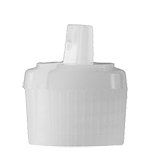Seals and Applications
How different seals work and best applications of each
Dispensing closures are very popular in plastic bottle applications. They are mostly utilized in liquid and cream type products such as lotion, cream, body wash, salad dressing, and honey. To understand how dispensing closures work, let’s first look at how these closures make a seal with the bottle to prevent leakage and allows for repeated use.
Since these dispensing caps needs to provide leak free seal when closed and easy pour when opened, they must create a good seal with the bottle to prevent unintended leakage. Common sealing systems includes:
- Crab Claw Seal
- V Seal
- Plug Seal
- Land Seal
Crab Claw Seal

Crab claw seal is named after its shape, it is a thin flexible seal that compresses against the top sealing surface, or the land, of the bottle during the normal capping operation. It acts like a gasket or a liner when engaged and is considered a universal seal. This type of seal requires the bottle to have a land area to make proper contact, and it must be flat and free of scratches, gouges and pitting. Since crab claw seal requires compression, it is best suited to be used with continuous thread (CT) closures.
Many of our disc top closure features crab claw seal.
V Seal

Shaped like a V, it is a small, non-flexible ring that makes contact with the plastic bottles land area. It is mostly found in tube dispensing caps. Similar to crab claw seal, it requires compression to be effective, and therefore best suited to be used with continuous thread (CT) dispensing caps.
Plug Seal

The plug seal fits into the bottle neck and seals against the inside diameter of the plastic bottle (I dimension … see “Plastic Bottles And Glass Bottles Neck Finish Dimensions” in Packaging Resource Guide).
In order for this type of seal to be effective, the sealing surface of both the plastic bottle and closure must be within a specific dimensional tolerances and surface quality. This type of seal is commonly found in snap-on style dispensing closures.
Land Seal

Land seal consists of a flat surface inside the closure. This surface makes contact with the land of the plastic bottle. It is generally supplied with a liner. It requires the land of the plastic bottle to be free of nicks, scratches, and gouges. Like the crab claw and V seal, it is commonly found in continuous thread (CT) dispensing closure, as it requires compression for the land seal to be effective.
Dispensing Cap Application Torque
Since many of the aforementioned sealing system require good compression to be effective, it is a good idea to revisit closure application torque for proper seal.
Application torque is the rotational force a threaded closure is applied to the bottle finish and is measured in inch-pounds. The following table outlines the appropriate application torque values of several common neck finish sizes:
| Closure Type |
Neck Finish |
Application Torque (in-lb) |
| Tube Top |
1” |
1-4 |
 |
1-3/8” |
1-4 |
| 1-1/2” |
8-12 |
| 2” |
8-12 |
| T-13 |
6-10 |
|
| Disc Top |
20-410 |
8-12 |
 |
20-415 |
8-12 |
| 24-410 |
10-18 |
| 24-415 |
10-18 |
| 28-410 |
12-21 |
| 28-415 |
12-21 |
| 2” |
8-12 |
|
| Snap Top |
15-415 |
6-9 |
 |
20-410 |
8-12 |
| 20-415 |
8-12 |
| 24mm |
10-18 |
| 24-410 |
10-18 |
| 24-415 |
10-18 |
| 28-410 |
12-21 |
| 28-415 |
12-21 |
| 30mm |
12-21 |
|
| Pour Spout |
28-400 |
12-21 |
 |
33-400 |
15-25 |
| 38-400 |
17-25 |
*Please note that this table is meant for reference only, different manufacturers may have different optimal application torque.
So what happens if the closure is not torqued properly? Here are some characteristics associated with improper torque application:
- Excessive Torque
- Ineffective seal between plastic bottle land and the cap
- Lid-fault: Visible gap between lid and deck
- Closure fracture
- Hinge damage
- Shearing of lid from the body
- Bulging of the closure that may fail during distribution or on the shelf
- Closure strips off the bottle
- Insufficient Torque
- Product leakage
- Liner does not seal to the bottle
- Rattling with the closures that leads to caps falling off during transit
So how do you accurately measure application torque directly? The answer is you cannot. For this reason, the packaging industry developed a standard to measure removal torque of caps applied by the capping machines. By measuring the amount of force it takes to remove the cap, a relationship is established between application torque and removal torque. By comparing these measurements based on manufacturer’s recommendations and the removal torque readings from the capping machine, you can determine the application torque and make adjustments accordingly. (You can click here for a detailed explanation of how it works).
Since application torque can be affected by temperature, material, product, moisture, and capping equipment, always perform testing to determine optimal application torque prior to mass production.







































